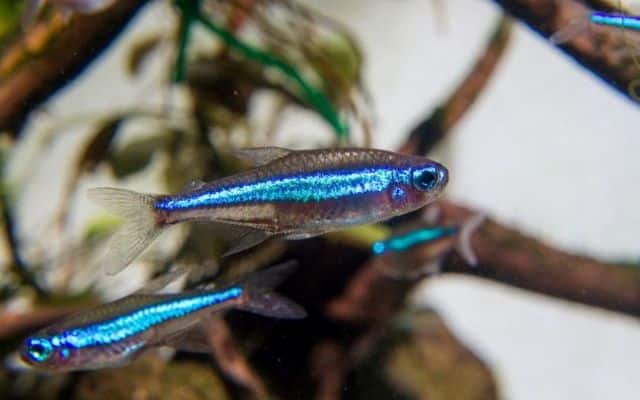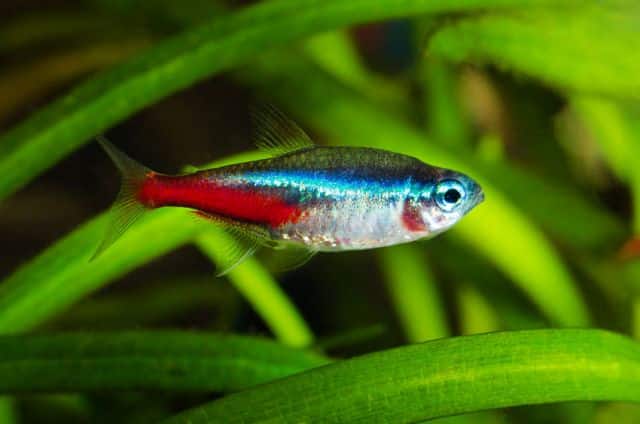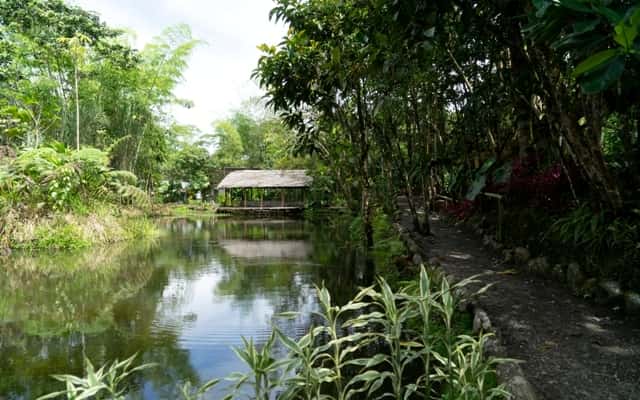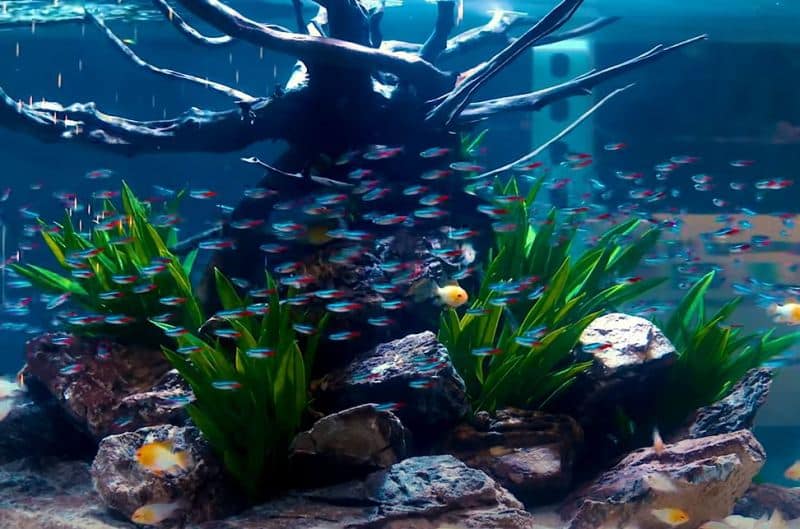Healthy Green Neon Tetra (Paracheirodon Simulans) – 9 Sections + Images
Green Neon Tetra scientific name: Paracheirodon Simulans
What do green neon tetras look like and how long will they live?
What they look like: Green Neon Tetras have a torpedo-shaped body, metallic scales, base grey coloration, and horizontal stripe.
As you can see in the pictures on this page, they are similar to Neon Tetras except they are missing the red pigmentation.
Age and length: Green neon tetras will grow to be about one inch long and could live to be 5 to 8 years old.
Neon Tetra Disease: Because of Neon Tetra Disease it is unlikely your fish will live much past a year.
Image above: Green Neon Tetra
Regular Neon Tetra
Where are green neon tetras found in the wild?
Green neon tetras are freshwater fish native to the tropical waters of South America, particularly Brazil, Colombia, and Venezuela.
If you look at the map below, their habitat is outlined.

Experience These Article in Audio Using Your Browser!
If a system or browser is not mentioned here, the I haven't been able to find out how to make the system or browser work to read aloud.
PC's: Using the Edge Browser, left click on the article text and scroll down to "Read Aloud." The article will automatically be read to you.
iPhone using the Edge Browser: Using the Edge brower, tap the icon that looks like a book with a speaker located in the in the address bar. The article will come up now showing 4 icons on top. Tap on the second icon from the right to have the article read to you.
Android phones: Google Assistant is the most convenient way. Say, "Google, read this page."
Corydora
Panda Corydora Care
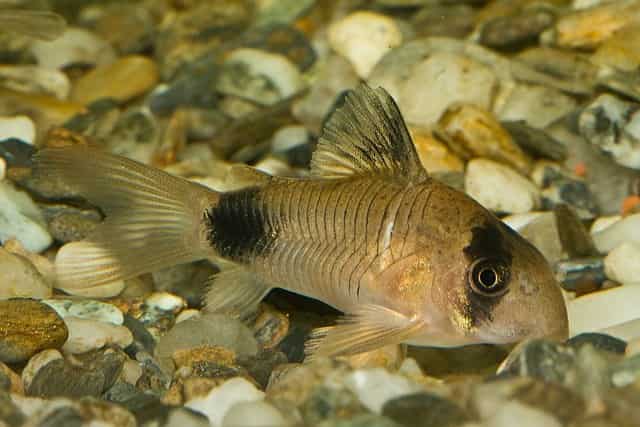
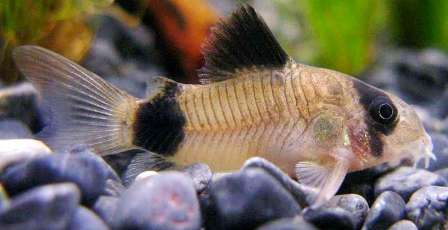
Categories: Small Fish, Peaceful Fish
3. What is their natural habitat like?
Green neon tetras’ natural habitat is exclusively black waters, thick with vegetation, fallen branches, and organic matter. They prefer gentle water flow.
The water they live in is acidic to very acidic.
Picture above: South American Amazon waterway. A habitat a Green Neon Tetra would like.
6. What is the ideal aquarium setup for Green Neon Tetras?
Green Neon Tetras share some characteristics and tank preferences with other tetras.
Aquarium size
Because of how small they are, GNT (Green Neon Tetras) can thrive in smaller aquariums. Best suggestion is to have one gallon of water to each tetra. If it were my tank, I would have 2 gallons of water for each fish.
Below is a video of 600 tetras in one round aquarium. This is really cool. Tap the picture to view the video. Opens in a new tab.
How to create GNT paradise in your home
Green neon tetras’ natural habitat consists of plants, fallen trees, roots, and rocks.
The water is what is called “black water” by seasoned fish keepers. This means it is filled with rotting plants and leaves which causes the water to become dark and acidic.
The soil in the GNT’s home is dark reddish-brown to black. These tells you what color the aquarium gravel should be.


Picture above: Orinoco River (visible at the top of the photo) and an off shoot stream or pond. Perfect Green Neon Tetra environment.
Behavior and tank-mates
This peaceful fish species will need community tank mates that are also small and peaceful as well. This includes, but is not limited to, other tetras, mollies, and guppies.
7. What should green neon tetras be fed?
Oh Magic Puppy: I'm feeding my Green Neon Tetra's people food. I can't afford fish food, so they have to eat what I eat. Will this work?
Magic puppy moves head the the side and looks puzzled.

Diet in its natural habitat
GNT are omnivores.
Green Neon Tetras eat any small insect or zooplankton that they can fit in their mouths.
They also nibble on plant materials like algae, fallen fruit, and even leaves.
Feeding and dietary requirements
Green neon tetras are rather easy to feed.
Give them just about any fish foods and they will chow down. This includes flake foods, frozen foods and cooked vegetables.
Like all fish, GNT’s will eat until they die. Take care not to over feed them.
How do you breed green neon tetras?
Mating, reproduction, and breeding
Green neon tetras are a polygynandrous species, meaning that males and females engage with multiple partners indiscriminately.
Subsequently, mating is commonplace, yet that does not make breeding an easy task. Green neon tetras require specific conditions to start the mating process (low pH of 6.5 or lower, very low water hardness plus plants and rocks. The survival rate for eggs and fry is low because of their high fragility and small size.
I’ve had cardinal tetras mate daily in the morning in a community 55 gallon tank I used to have. I used strictly reverse osmosis water which means 6.5 to maybe 7 pH and no hardness. I.E. super soft water with the temp. set at 78 degrees F.
How to tell males from females
The females might be a little rounder.
Breeding and hatching
If kept in a school, males will often compete for female attention and display brighter colors as they swim around her. If the female accepts, the breeding process starts.
Female green neon tetras lay over a hundred eggs on top of the substrate or plants with fine leaves, but always in shaded areas of the tank. Light and UV radiation will damage eggs and newborn green neon tetras, which is why lower illumination levels are required.
After the male fertilizes the eggs, they hatch within 24 hours. Green neon tetra fry are still sensitive to UV radiation, so they should be raised in a shaded / darker tank.
The fry can be fed infusoria or liquid fry food until they are large enough to take highly powdered flake food and baby brine shrimp.
8. What are common diseases of Green Neon Tetras?
Green Neon Tetras are delicate fish that are not a common breed in the hobby. (I have seen them for sale in the local big box pet store in the past). Subsequently, odds are your fish were captured in the wild. This makes them more vulnerable to stress and common tank diseases.
It’s important for the well-being of your GNT’s that you understand the symptoms and treatment of prevalent diseases, such as the following.
Shock
It has been discussed how GNT’s are susceptible to fluctuating water conditions. Deteriorating water quality most always results in shock, stress, and vulnerability to further diseases is to keep your water parameters steady and avoid fluctuations. Likewise, make sure to add them to established and mature aquariums.
Ich
With shock comes Ich. Unstable water parameters and fluctuating temperature can induce the growth of protozoans responsible for this parasitic disease. I.E. This is the fish keeper’s fault.
Ich’s most distinctive symptom are white spots all across the fish’ body, clamped fins, appetite loss, and constant gasping.
Treating ich requires both medication and a shift in the tank’s water parameters. Malachite green, aquarium salt, and copper sulfate are sufficient to kill the parasite. Also increase the water temperature, as well as make larger, more frequent water changes. All of these steps show lead to complete recovery.
Neon Tetra Disease
The most significant threat to the health of your green neon tetra fish is the aptly named “neon tetra disease”, a prevalent disease for this species that has no known cure.
Of note: I have read some fish keepers articles that have said the protozoan responsible for this disease is always present in all aquariums.
Neon Tetra Disease is caused by Pleistophora hyphessobryconis, a protozoan that is often transmitted through infected live food, as well as through diseased fish being added to the tank. The infected fish develop damaging cysts, a dull coloring, and a curving of the spine.
Once infected, the only solution is to remove the affected fish to avoid a widespread epidemic in the tank.
Conclusion
My opinion on keeping Neon Tetras or Green Neon Tetras in “don’t.” I’m fairly certain they will die quickly in your care.
That said, if you are really serious about making sure their water pH hangs around 6 and hardness is zero or nearly zero, you might have some luck at keeping GNT’s.
Leave a comment at the bottom of the page to let me know about your experience with Neon Tetra, GNT.s or Cardinal Tetras.
Keeping fish can be costly, but there's a great way to offset those expenses.
Consider creating your own income producing website, just like I did with this one! I advertise Divi website creator, but you could place other ads on your website.
I've used Divi Wordpress website builder to build this site, and it's incredibly user-friendly. With its drag-and-drop interface, creating your own website becomes a breeze.
Simply tap this box to get started and see how easy it is to create a website with Divi.
The cost is $89/year. This is $7.41 per month. Divi comes with a 30 money-back guarantee. Try it at no risk.
Take this box to visit the Divi website to learn more. The link opens in a new window.
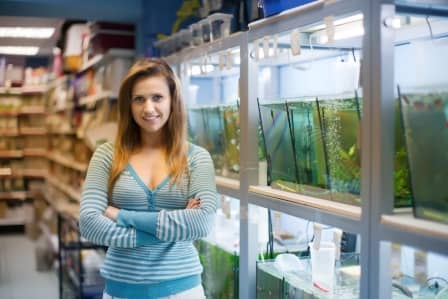
* Great Video: How to make a Website | Divi Tutorial 2024
